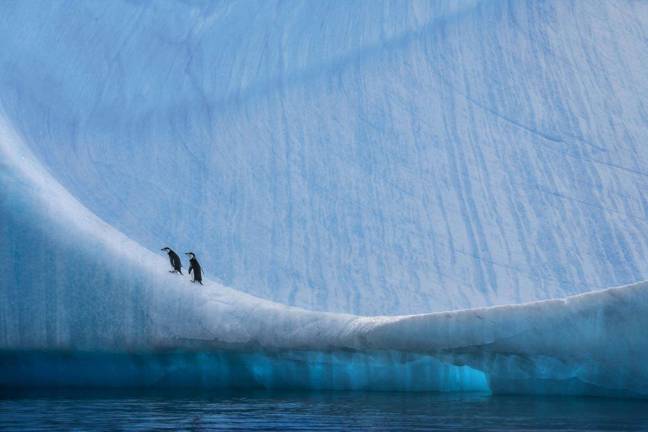polar purpose




You might not know Paul Nicklen by name, but you probably know him by his photographs. Nicklen’s images of the world’s polar regions — stark Arctic landscapes and intimate portraits of the creatures inhabiting them — have reached the eyes of millions from the pages of National Geographic magazine and through his popular Instagram account. Nicklen, a tireless conservation advocate, views his work as a call to action — a tool for inspiring and mobilizing people to preserve imperiled ecosystems and fight the effects of climate change.
The latest step in the Canadian photographer’s conservation efforts is an eponymous SoHo gallery, which launched last month on West Broadway and features large-format prints of his photos. Half of Nicklen’s proceeds from the venture support Sea Legacy, the nonprofit he started to highlight threats to marine ecosystems. Nicklen spoke with Our Town last week via telephone during a rare stint at home in British Columbia.
How often are you on the road?Probably 10 months a year, I’d say. I’m always fighting to spend some time at home, but it’s really hard. I could be on the road 360 days a year if I let it. So many people write me every day saying “Oh my gosh, I must have your job, just to travel the world and take pictures,” and they don’t realize what it means to be living in hotels and tents and airports all year long. So I love getting home, but I also love telling these stories.
Why did you decide to open a gallery in New York?Especially in a place like New York, I just see the disconnect that people have from the environment and nature. It’s a fantastic city full of great people who are passionate and care, but they have no idea about the urgency of how quickly these ecosystems are changing. As a journalist and a storyteller, by shooting all these images, it allows me to have a microphone.
I really did not want another gallery saying, “Here’s a pretty picture of a bear. I hope you like it, I hope you buy it. Thanks.” It’s a gallery to convene people to start a conversation about conservation. It’s a gallery about the urgency of our changing world. It’s a gallery that will bring in other talented artists, other photographers who can come in with their bodies of work and tell their story. And a large part of these proceeds go back to our nonprofit called Sea Legacy, which allows us to have the autonomy to go do our work.
It’s a convening place. It’s a place where people can come and learn and become aware. They can also get a feeling of hope. It was amazing at the gallery opening, with 2,000 or 3,000 people coming through — people are looking for leadership. They’re looking for guidance. They’re scared, they’re worried, and they need someone to give them some direction.
How have recent political developments affected your outlook?With Obama — or if it had been Hillary or definitely Bernie — you think, OK, politicians kind of have our backs. We’re gonna wait and see what they do. But the silver lining with Trump is that he makes it very clear that he does not care about anything to do with the environment. He’s blowing up the EPA and the environment is his least concern.
So I think that people have actually woken up and realized that nobody’s got their back now. That’s what excites me about being in New York. We all need to sort of start this movement together and we’re not going to be able to rely on any government figure or program or initiative to have our back, because they don’t. Now the people sort of have to rise up and take this into their own hands.
The experience of seeing a wall-sized photograph in the gallery is quite different from viewing the same image on a smartphone. What’s it like to see your work at that scale?I love to see my work big. With every image I shoot, I’m trying to find that cross-section of art, science and conservation. I want that image to be beautiful and transport people, whether it’s into a magazine or into their phone or — hopefully, definitely — into a really large, 60-inch by 90-inch print on the wall. You are transported into that world with that animal. I want people to look at these animals in the eye and feel themselves as a part of that ecosystem, and I think the fine art imagery creates that sensation. It’s almost like a 3-D experience of being there with these animals.
Your nonprofit helps fund nature photographers covering climate change and threatened ecosystems. Why do you view visual storytelling as so important in promoting conservation?Science is crucial — we need science — but it has failed to drive any change whatsoever, really, in the emotional connection that we have to these habitats and these species. When science is saying polar bears are going to disappear within the next hundred years, it sucks, but you feel kind of helpless and you kind of forget about it.
But all of a sudden you start to show pictures of polar bears dying and starving to death and it slaps you in the face. I’m there to sort of be a massive wake-up call to everybody. I’m there to break down the walls of apathy and to really connect people to the polar regions that are warming twice as fast as anywhere else on earth.
I can honestly tell you: it sucks to care. It really does. It’s emotionally gut-wrenching. It’s a bit draining. I wish I didn’t care so much. But once you start caring, it’s really hard to go back.
Portions of this interview have been edited and condensed for clarity.